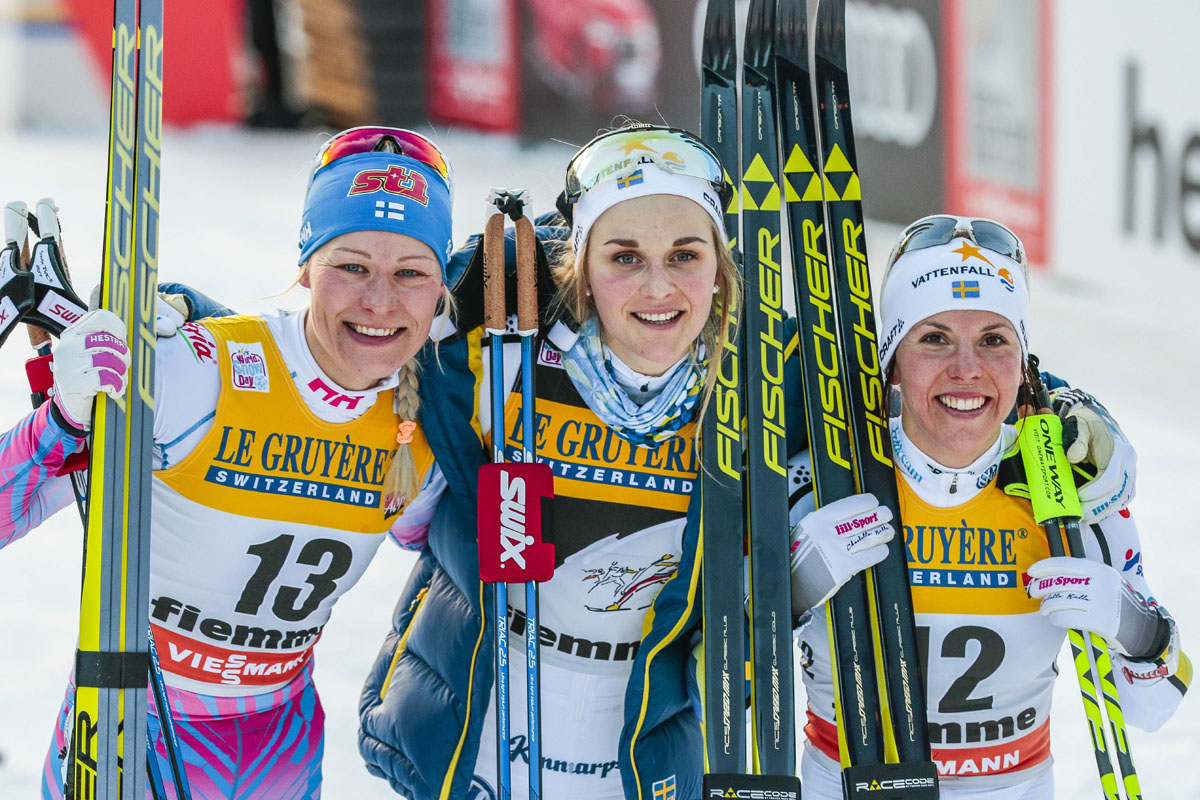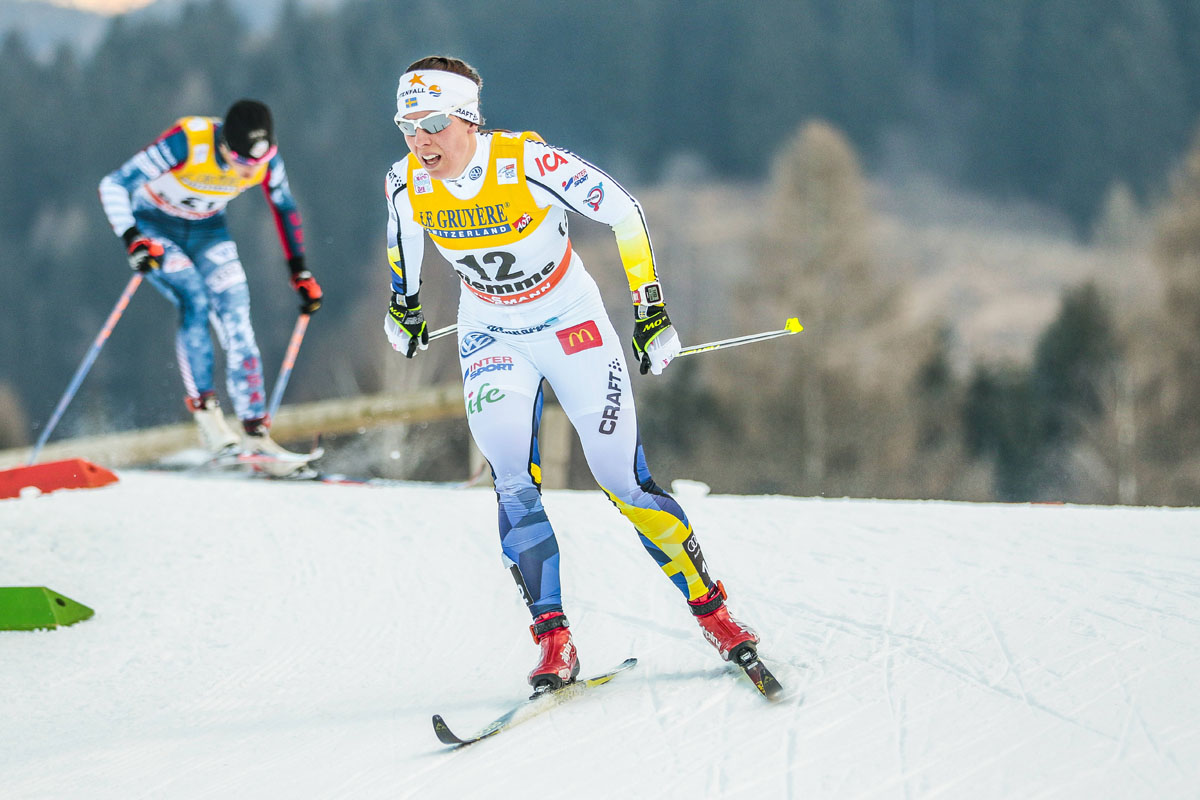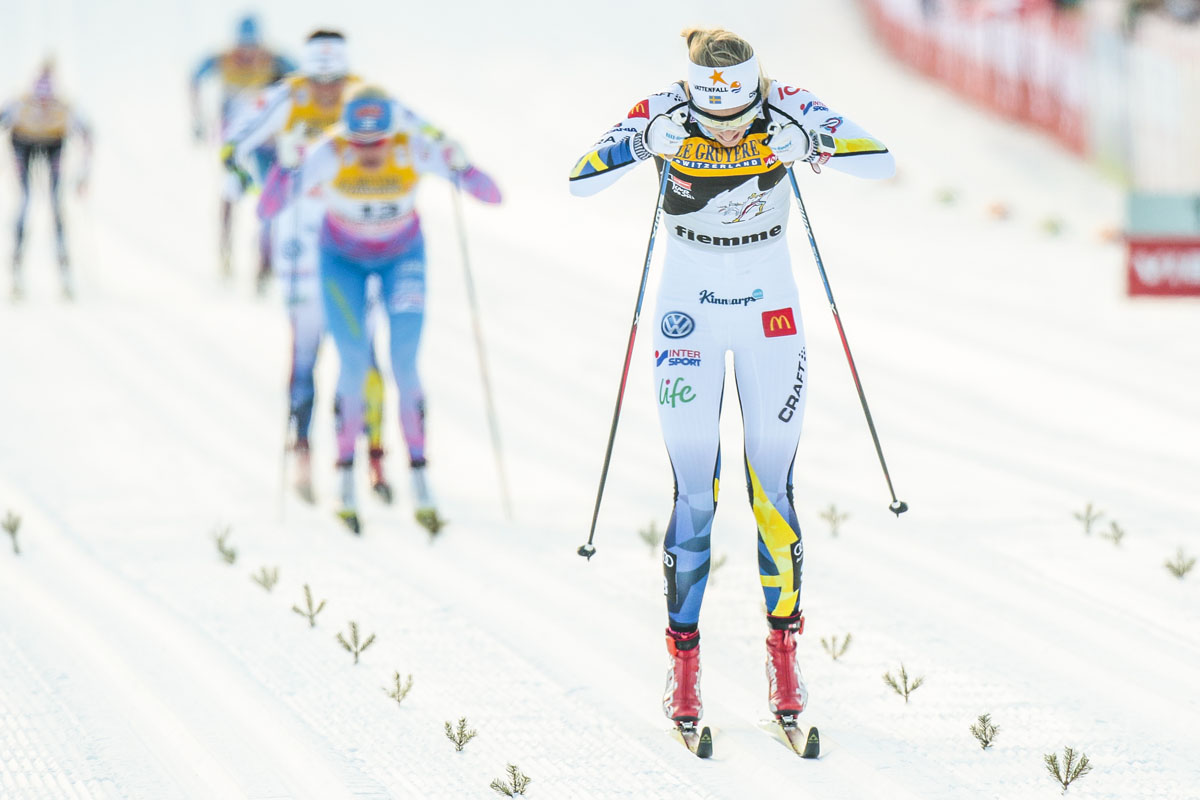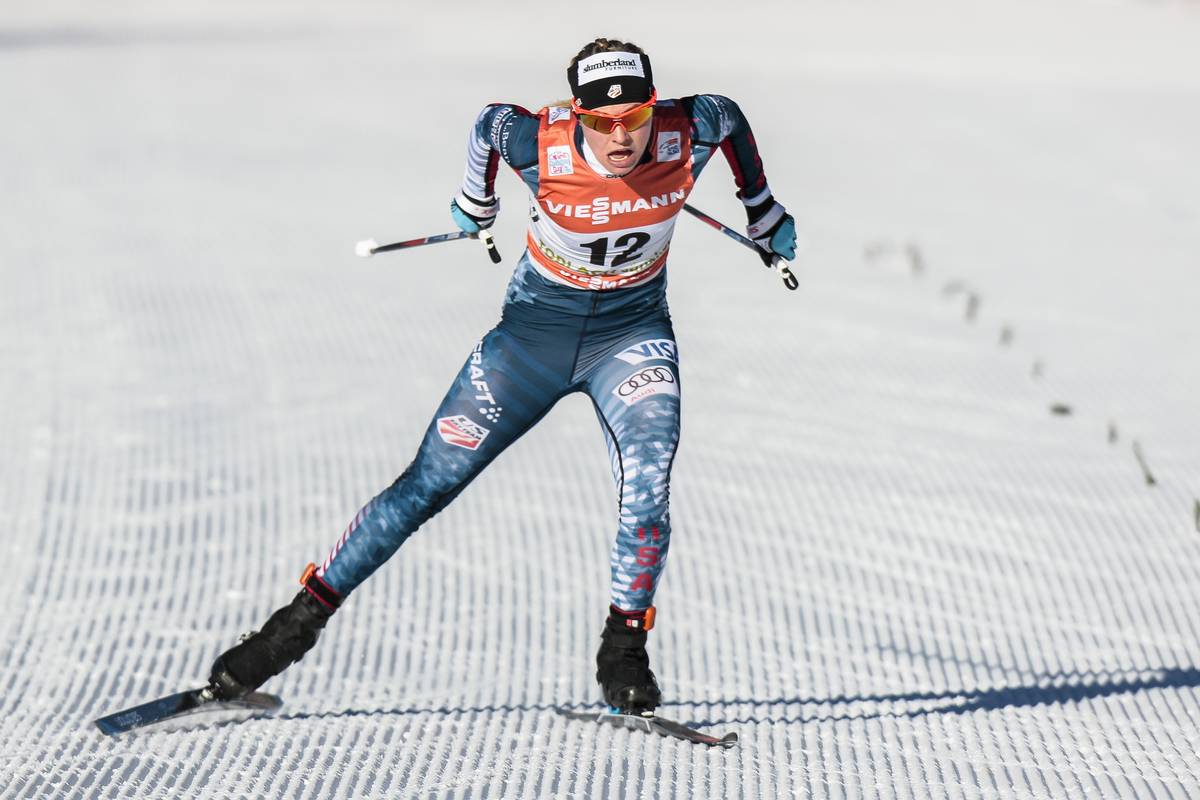
As the Tour de Ski drags on, the World Cup field is tiring. Nobody – except maybe Sergey Ustuigov – has managed six good days in a row.
Everyone else has had at least subpar race. But sometimes a good day follows a bad one. Just ask Sweden’s Stina Nilsson.
23-year-old Nilsson had been leading the Tour after winning three out of the first four stages. But she finished 20th in the 5 kilometer freestyle on Friday – 40.5 seconds behind the time set by Jessie Diggins, and far from seeing any bonus seconds. So she lost the lead.
Saturday was a brand new day: the 10 k classic mass start in Val di Fiemme. As Nilsson noticed her rivals in the overall Tour standings slipping – quite literally, as some struggled with slick skis – she pounced.
First she won the bonus sprint at 3.6 k. It wasn’t something that she had planned ahead of time, but the opportunity seemed ripe for the picking.
And then as the race went on, Nilsson stayed always near the front. By the final 2.5 k lap she decided to push up the hills. The rest of the pack fell away, all except for Anne Kylloenen of Finland.
Coming down the hill to the finish she was able to pull away from Kylloenen, too. That gave her a 3.0-second win — and 30 total bonus seconds, 15 for the first sprint and 15 for the win. Voila – now she is back in the Tour lead.
“It is amazing,” Nilsson marveled to FIS. “You never know how the body bounces back. Yesterday was a difficult day. I am really happy with today’s result.”

It was the first individual podium of the season for Kylloenen, and a strong day for Finland. Krista Parmakoski placed fourth (+9.4) and Kerttu Niskanen ninth (+19.8). The team is traditionally strong in classic skiing, and Kylloenen also credited their ski techs.
Charlotte Kalla was third, +3.7, in her first podium of the season. The Swede started the World Cup on a tough note, experiencing an atrial fibrillation in the Ruka, Finland, 10 k.
“It is great to be on the podium again, especially after I crashed today,” she told FIS. “I had to fight my way back in the race but in the end I felt very strong.”
While Kylloenen had praised her skis, one team wasn’t doing so. The Norwegians failed to reach the podium for a second straight day. Heidi Weng was their top finisher, in seventh (+17.5). She had been leading the Tour, but now sits 19.2 seconds behind Nilsson going into the final stage.
Kathrine Harsem finished 12th (+35.3) and Ingvild Flugstad Østberg 18th (+1:08.5). All three blamed their skis, which they said were too slippery and the worst in the field.
“It should be f–ing possible to wax properly, goddammit,” Harsem told NRK. “We have to try and put this behind us.”
For Østberg, it was a disaster in terms of the overall Tour standings, as she slipped from second place down to fourth, 1:23.3 behind Nilsson and 39.7 seconds behind third-place Parmakoski.
“It’s a lot to take in when you see your chances in the final standing go away,” she told NRK. “I am terrible at waxing myself so I’m not blaming anyone. They do all that they can and we do all that we can. You can’t always hit the bullseye, but of course it is even more frustrating when it’s a Tour.”

As for Weng’s chances of winning the Tour de Ski, they are still decent. She is currently 19.2 seconds behind Nilsson overall.
The final stage is a grueling 9 k climb up the Alpe Cermis, a stage where Weng has excelled in the past.
“It’s fun to still be in the race, “ Nilsson told Expressen. “It’s Heidi Weng and it’s Alpe Cermis… I see myself absolutely not as the favorite. But it’s fun to still be in the game a little bit.”
Nilsson hasn’t excelled in the climb – but she is also a much stronger skier than she was last season.
“Stina is in better shape than ever,” Weng told Expressen. “I don’t know if I will take her on the slopes in the morning.”
Diggins Eighth, Holds Tour Position
With her recent flurry of podiums and wins, eighth place might seem like a standard day for the U.S. Ski Team’s Jessie Diggins.
But in the 10 k classic? Not so much. Sure, she was eighth in the 10.5 k classic Ski Tour Canada stage in Montreal last season, but there she was 1:43.5 behind the winner, Therese Johaug (and 43.2 seconds behind second-place Weng).

In Val di Fiemme, Diggins was eighth and only 19.5 seconds behind the day’s winner, Nilsson.
“I was psyched,” Diggins said in a phone interview. “I don’t know that I’ve ever been within 19 seconds of the leader in a 10 k classic.”
The result came from a combination of attitude and strategy, Diggins said.
Attitude: “I was channeling my classic-loving teammates today, thinking, ‘Okay, what would they do? They would not fall down, they would stay upright on the climbs. So I’m going to try to do that too.’ And basically, I raced today thinking only positive things to myself.”
Positive thinking can get you far – Diggins knows that as well as anyone. But she also knew she had to race smart. In order to have the best possible final Tour de Ski position, she was racing for time back from the winner, not necessarily place. So she picked her battles.
“I was trying to stay within sight of the leaders for absolutely as long as possible,” she said. “That meant that when everyone was kind of sprinting for the bonus sprint, I didn’t do that because I didn’t want to implode. So then I was able to reel my way right back in afterwards, and I was really psyched about that.”
For much of the race she held on to the back of the lead group, never falling off, but rarely part of the mêlée.
“People are switching lanes, cutting each other off, stepping on each other, and I was like, ‘Okay. I’m just going to do my thing in the back, and ski as smooth as I can’,” Diggins explained. “And then I knew the pace was going to go up on the last lap. I wanted to be able to respond to that attack as well as I could, so I just kind of stayed out of trouble. And that tactic worked out well for me today.”
A number of racers, including Kalla and Parmakoski, fell on a sharp corner coming into one of the course’s steep downhills. That, too, was a reason for Diggins to use caution.
“The worst thing I could do for myself in this race is to have some accident happen and lose a ton of time,” she said. “There was a little bit of a hairy corner there. I watched a girl half jump over another skier to avoid a crash. I remember thinking, ‘Wow, I’m so impressed. It’s the middle of the race, but I’m just so impressed right now.’ So I stood up [to avoid it]. I just wanted to stay out of trouble.”

As Nilsson upped the pace on the final lap, Diggins found it harder to stay with the leaders. She put her head down and dug, and knew that she had one trick card up her sleeve: the course’s downhill finish.
If the Tour de Ski has demonstrated anything, it’s that Diggins loves downhills.
“I knew that I had a chance of catching the girl in front of me if I really skied the downhill perfectly, and then hopped out of her draft at the right time,” she said. “It was really fun to actually execute a long-distance slingshot. [Niskanen] gapped me over the top of the hill. Kerttu’s a really good skier. But it was really fun to be able to actually pull it off.”
All in all, Diggins wanted to be there for the final sprint, to be close to the winner – but being 20 seconds back, she’d take it. She credited Niskanen with helping her not lose more time on Nilsson.
“We helped each other give everything we had,” she said. “When you’re duking it out with someone, you both move faster, which was cool… 10 k classic has never been my marquee event, I guess you could say. But I was really proud of myself for giving it my best shot. And not giving up, and really just going after it.”
More Points for Stephen and Brennan
By the end of the first lap, American Liz Stephen – starting from bib 21 – was holding her position and within ten seconds of the leaders.
But within a kilometer, Stephen found tat she couldn’t hang on.
“Classic is just a continuous work in progress for me, and I was hoping to feel a little more energetic out there than I did,” she admitted in a phone call. “But it’s my favorite course on the World Cup, so I was having fun out there, for sure. There seems to be this gap that I can’t quite close in classic. It happened again today. Right off the back of the leaders, and right off the back is just not close enough. Then the gaps open and I’m not there to cover the gaps, and they just get bigger and bigger.”
She finished 19th – 1:11.2 behind Nilsson, just one spot behind Østberg.
“Hell, I almost beat Ingvild today, and that doesn’t quite feel right,” Stephen said. “I certainly got to ski right behind her, which I haven’t done for five or six years. There were some highlights… I really do enjoy skiing with Steffie [Boehler, of Germany]. I was skiing the downhills well today. There’s a lot of positives for sure, but I was hoping to be just a little closer to the lead pack today.”
Teammate Rosie Brennan also had a strong start, immediately moving up eight or so places from her bib number. But then she got tangled on an uphill and it was the straw that broke the camel’s back, in terms of keeping the pace.
“We got to the top of the course and it’s a short steep pitch, like a herringbone, and I got stepped on and face planted there,” she explained in an interview. “I just lost my steam. So I had to reset then. I felt really beat, and didn’t have much there, and just tried to keep a steady pace, keep chugging along. I figured if I kept steady I would pick off a few people who had exploded. So that’s how the rest of the race went.”
By the finish Brennan had moved up to 28th (+2:06.1). She scored a few more World Cup points and is now in 30th in the Tour overall.
“I didn’t lose that much time, so it’s hardly an excuse,” she said. “But I was just tired enough that it threw me off a little bit. It was much easier to follow today than to chase, so I would have preferred to have been following. But that said, I didn’t lose that much time, so it’s not much of an excuse, just a bummer.”
Sadie Bjornsen, the fourth member of the U.S. team on the start list, skipped out on the rest of the Tour due to illness.
American Outlook for the Alpe Cermis
It’s vanishingly unlikely that an American will win the Tour de Ski.
But one, Liz Stephen, is intent on winning the climb. Three times — 2013, 2014, 2016 – she has had the second-fastest time up the Alpe Cermis. Tomorrow she hopes to do one better.
“I’m certainly going to go out and try to catch some people, but my goal tomorrow is to win this big climb,” she said. “That’s certainly the goal, and it’s been on my radar all year. With [Therese] Johaug out of the mix [for a doping violation], I think it’s a possibility if I have a really good race. That’s the goal… I feel really ready for tomorrow. I know that everybody is tired. I’m tired too. But I’ve been looking forward to this for 364 days, so it’s go time!.”
For Diggins, who has held onto fifth place for several stages now, the climb represents another chance to simply push really, really hard.
“My whole strategy to the Tour this year, and every year, has just been day by day,” she said. So tomorrow, I think it’s the exact same approach: just go out there and it’s gonna be hard, of course, I mean, we’re climbing a mountain. But I’m just going to go out there and ski it as well as I can, and be as mentally tough as I possibly can. And I know that’s my strength, is I can dig really deep and I can deal with a lot of pain, and I can grind it out. So I’m just going to take confidence in that and go for it.”
All of the Americans said the same thing: you know what you’re signing up for when you decide to do the Tour de Ski. You’re signing up to climb a mountain after you already have half a dozen races in your legs in just one week’s time.
Brennan was philosophical about it.
“I’m quite tired. But I think sometimes when you’re tired the hill is easier than doing a race, because there’s a lot less thinking,” she said. “You’re just putting one foot in front of the other, and you don’t have to think about how to make speed, or skiing around a corner. From that aspect I feel like it will be OK. I’ll make it.”
Chelsea Little
Chelsea Little is FasterSkier's Editor-At-Large. A former racer at Ford Sayre, Dartmouth College and the Craftsbury Green Racing Project, she is a PhD candidate in aquatic ecology in the @Altermatt_lab at Eawag, the Swiss Federal Institute of Aquatic Science and Technology in Zurich, Switzerland. You can follow her on twitter @ChelskiLittle.



